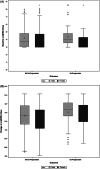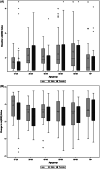Sex-specific disparities in COVID-19 outcomes
- PMID: 38283615
- PMCID: PMC10811409
- DOI: 10.1002/emp2.13110
Sex-specific disparities in COVID-19 outcomes
Abstract
Objectives: Sex-specific disparities in morbidity and mortality of COVID-19 illness are not well understood. Neutralizing antibodies (Ab) may protect against severe COVID-19 illness. We investigated the association of sex with disease progression and SARS-CoV-2 Ab response.
Methods: In this exploratory analysis of the phase 3, multicenter, randomized, placebo-controlled Convalescent Plasma in Outpatients (C3PO) trial, we examined whether sex was associated with progression to severe illness, defined as a composite of all-cause hospitalization, emergency/urgent care visit, or death within 15 days from study enrollment. Patients had a positive severe acute respiratory syndrome coronavirus 2 (SARS-CoV-2) test, symptom onset within 7 days, stable condition for emergency department discharge, and were either ≥50 years old or had at least one high-risk feature for disease progression. Patients received blinded convalescent plasma or placebo in a 1:1 fashion and were evaluated on days 15 and 30 after infusion. Blood samples were collected on day 0 (pre-/post-infusion), 15, and 30 to measure Ab levels with the Broad Institute using the Plaque Reduction Neutralization Test assay.
Results: Of 511 patients enrolled (median age 54 [Iinterquartile range 41-62] years, 46% male, 66% white, 20% black, 3.5% Asian), disease progression occurred in 36.7% of males and 25.9% of females (unadjusted risk difference 10.8%, 95% confidence interval [CI], 2.8-18.8%). Sex-disparities did not persist when adjusted for treatment group, age, viremic status, symptom onset, and tobacco use (adjusted risk difference 5.6%, 95% confidence interval [CI], -2.2% to 13.4%), but were present in the subgroup presenting 3 or more days after symptom onset (adjusted risk difference 12.6%, 95% CI, 3.4% to 21.9%). Mean baseline Ab levels (log scale) available for 367 patients were similar between sexes (difference 0.19 log units, 95% CI, -0.08 to 0.46). The log-scale mean increase from baseline to day 15 after adjusting for treatment assignment and baseline levels was larger in males than females (3.26 vs. 2.67). A similar difference was noted when the groups were subdivided by outcome.
Conclusions: Progression of COVID-19 was similar in males and females when adjusted for age, tobacco use, and viremia status in this study. However, in the cohort presenting 3 or more days after symptom onset, COVID-19 outcomes were worse in males than females. Neutralizing Ab levels increased more in males but did not correlate with sex differences in outcomes.
Keywords: C3PO; Covid‐19; outcomes; sex disparity.
© 2024 The Authors. JACEP Open published by Wiley Periodicals LLC on behalf of American College of Emergency Physicians.
Figures



References
-
- WHO Coronavirus (COVID‐19) Dashboard. WHO coronavirus (COVID‐19) dashboard with vaccination data . Accessed June 21, 2023. https://covid19.who.int/
Grants and funding
LinkOut - more resources
Full Text Sources
Miscellaneous
